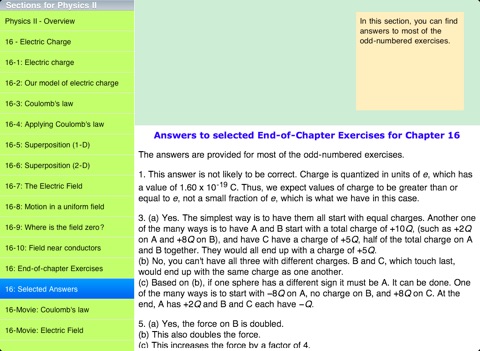
This app covers the Physics that is included in the second semester of a typical introductory college physics course (Physics I HD is a companion app with the first-semester material). It is also appropriate for high school physics. The app is essentially an interactive Physics textbook. In addition to standard textbook material, the app also has simulations and animations, as well as movies. Version 2.7 includes all 15 chapters.
Chapter 16 covers electric charge, going through the basic model we use for charge, Coulombs law, and electric field. The emphasis is on the concepts, but there are also over 60 end-of-chapter exercises included.
Chapter 17 covers electric potential energy and electric potential. As with chapter 16, each section of chapter 17 has a simulation or an animation, and there are approximately 60 end-of-chapter exercises.
Chapter 18 covers Direct Current (DC) Circuits. This is a relatively large chapter, with 10 sections.
Chapter 19, on Magnetism, includes a discussion of the force exerted by charged particles and current-carrying wires by magnetic fields, and a look at how magnetic fields are created in the first place.
Chapter 20 covers electromagnetic induction (this is how most electricity is generated). The chapter discusses Faradays law, Lenzs law (including a pictorial method for doing Lenzs law), motional emf, eddy currents, electric generators, and transformers.
Chapter 21 covers waves and sound. There are animations of transverse and longitudinal waves, Doppler effect situations, as well as standing waves.
Chapter 22 covers electromagnetic waves. Topics discussed include Maxwells equations, electromagnetic waves and the electromagnetic spectrum, the Doppler effect for EM waves, radiation pressure, and polarized light.
Chapter 23 deals with the reflection of light and the formation of images by spherical mirrors. Chapter 23 includes interactive ray diagrams for both convex and concave mirrors.
Chapter 24 covers refraction and lenses. The discussion includes Snells law, total internal reflection, and ray diagrams for lenses, and the simulations include interactive ray diagrams for both converging and diverging lenses.
Chapter 25 covers interference in two dimensions, diffraction, as well as thin-film interference.
Chapter 26 is on Special Relativity. The chapter covers the spacetime interval, the spacetime diagram, time dilation and length contraction, and discusses simultaneity.
Chapter 27 is an introduction to the quantum world. Chapter topics include blackbody radiation, the photoelectric effect, the Compton effect, and the Heisenberg uncertainty principle.
Chapter 28, The Atom, covers models of the atom, the quantum picture of the atom, the periodic table, and quantum applications.
Chapter 29 covers the nucleus. Highlights in this chapter include a discussion of alpha, beta, and gamma decay; exponential decay; and an overview of fusion and fission.
Chapter 30 includes a discussion of inductors and inductance; RL circuits; and various aspects of AC circuits, including the impedance triangle and graphs of voltage as a function of time. The chapter ends with a look at resonance.



